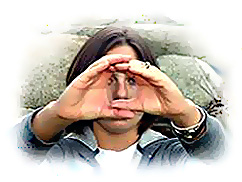Protective equipment
bracer (arm-guard): to protect the inside of the bow arm from being hit by the string and prevent clothing from catching the bow string. The bracer does not brace the arm; the word comes from the armory term "brassard", meaning an armored sleeve or badge.
plastron (chest guard): prevents the clothing from coming into contact with the string.
y-finger glove: provides maximum air flow and hand movement whilst protecting the knuckles/hand from damage.
3-finger glove: protection for both the drawing fingers and the bow hand.
tab: protection for the middle 3 fingers of the drawing hand.
Identifying the dominant eye is an essential first step in learning to shoot with accuracy and precision. Just as most individuals are right or left-handed, visual acuity and focus can be much stronger in one eye than in the other. This difference can have a significant effect on the accuracy of long-distance shots, so making an accurate determination of the dominant eye is vital for competitive shooting and hunting activities. Unfortunately, the process of identifying the eye that dominates in focus and accuracy is not as simple as determining handedness in most cases.
Numerous methods have been developed for determining which eye is dominant in a particular individual. Most of these methods require focusing on a distant object with both eyes through some type of obstacle. The obstacle should be positioned to block one eye or the other, but not both at the same time. In most cases, the viewer will naturally position the eyes to provide the best possible view for the dominant eye. The most common testing methods include the following:
- The Porta Test requires the test subject to extend one arm at full length and raise the thumb, aligning it with a distant object. The subject then closes one eye at a time; the one that is aligned with the object is typically the dominant eye.
- The Miles Test and the Dolman Method operate on the same principle. The Miles Test involves the use of the hands to frame a faraway, small object. By looking through the opening in the hands and then closing each eye in turn, the subject can identify which eye is being used to observe the distant object. The Dolman Method works in the same way but uses a card with a hole cut into it instead of the subject’s own hands.
In some cases, the results of these tests may be inconclusive; this may be due to eyestrain or to cross-dominance, a condition in which both eyes are equally dominant. Recreational target shooting requires a high degree of focus and visual acuity, so determining the correct eye for aiming purposes can make a significant difference in the results achieved in this competitive sport.

